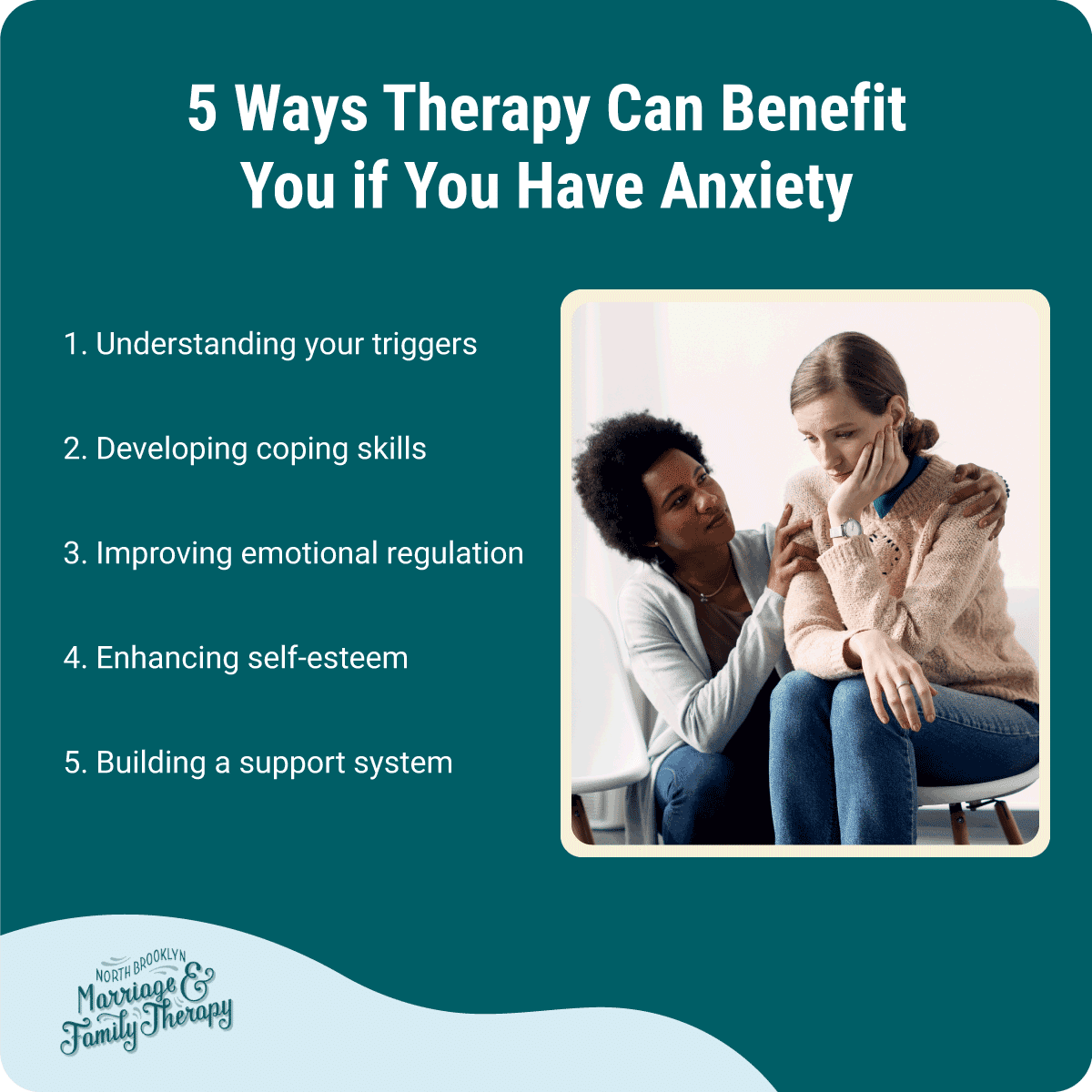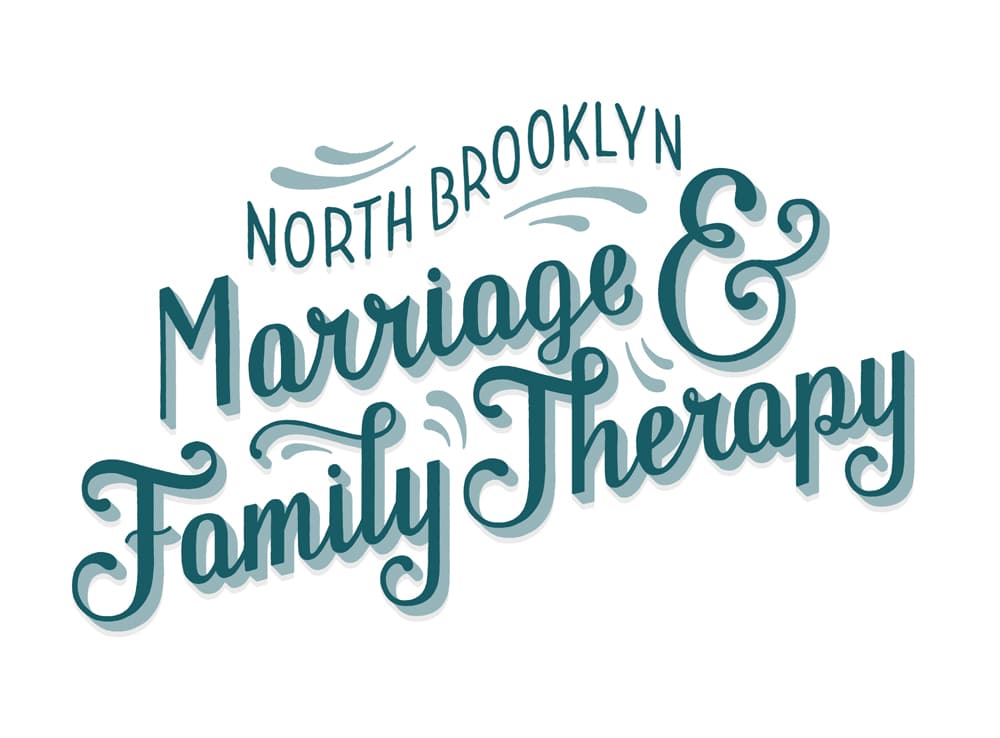Anxiety Therapy Services in Brooklyn, NY
Anxiety can deeply impact your daily life, affecting your thoughts, emotions, and well-being. If you’re struggling with anxiety, it’s essential to reach out for compassionate and qualified therapeutic support.
What is Anxiety?
Anxiety is a common and natural stress response that keeps us alert and focused. It’s an emotion that everyone experiences and can be very healthy for daily life. For instance, a moderate level of anxiety before a significant event, such as an exam or a job interview, can motivate us to prepare thoroughly and perform at our best.
However, when anxiety becomes overwhelming and starts to interfere with daily life, it may be time to seek help through anxiety therapy. Anxiety therapy can provide the necessary support and strategies to manage these unhealthy symptoms of anxiety more effectively. If you’re in Brooklyn, NY, our specialized anxiety therapy services are designed to help you regain control and improve your quality of life.
Healthy vs. Unhealthy Anxiety Symptoms
Understanding the difference between healthy and unhealthy anxiety can help you recognize when anxiety is motivating and when it may be hindering your well-being.
Healthy anxiety looks like this:
- Increased alertness: Helps in quick thinking and responsiveness.
- Enhanced concentration: Keeps you focused on essential tasks.
- Improved performance: Motivates thorough preparation for events.
- Motivation to act: Drives action and reduces procrastination.
Unhealthy anxiety symptoms include:
- Excessive worry: Persistent and excessive worry affects daily focus.
- Avoidant behaviors: Avoiding situations or tasks due to anxiety.
- Physical symptoms: Includes headaches, stomach issues, muscle tension, and fatigue.
- Impaired functioning: Interferes with daily activities and productivity.
Even if you aren’t experiencing all the typical symptoms of anxiety, it’s important not to ignore the diagnosis. If you’re struggling with anxiety, our compassionate and qualified therapists at North Brooklyn MFT are here to help. We have the expertise to guide you through effective strategies for managing your mental health.
When to Seek Therapy for Anxiety
Therapy can be essential for managing unhealthy anxiety if you experience any of the following:
- Persistent worry or fear: Excessive and disproportionate worry about everyday events.
- Physical symptoms: Increased heart rate, sweating, trembling, headaches, and fatigue.
- Avoidance behaviors: Avoiding social situations or activities due to anxiety.
- Difficulty concentrating or sleeping: Trouble focusing or sleeping due to anxious thoughts.
- Panic attacks: Symptoms include chest pain, shortness of breath, dizziness, and a sense of impending doom.
- Interference with daily activities: Struggling to meet obligations due to anxiety.
- Impact on relationships: Anxiety causing conflicts or withdrawal from social interactions.
- Substance use: Using alcohol, drugs, or other substances to cope with anxiety.
Diagnoses Included for Anxiety
Anxiety can manifest in several forms that might require professional intervention. Anxiety diagnosis may include:
- Generalized Anxiety Disorder (GAD)
- Obsessive-Compulsive Disorder (OCD)
- Post-Traumatic Stress Disorder (PTSD)
- Social Anxiety Disorder (social phobia)
- Panic Disorder
- Specific phobias
The Benefits of Therapy for Anxiety

Seeking therapy for anxiety offers numerous benefits, such as:
- Identifying and understanding what triggers your anxiety.
- Learning effective coping skills and techniques like CBT, relaxation, and mindfulness.
- Improving emotional regulation to regain control.
- Boosting your self-esteem and confidence.
- Building a support system with compassionate support in a safe, non-judgmental space.
Therapy Types for Anxiety
Anxiety is a natural part of life, but when it becomes overwhelming and interferes with daily functioning, anxiety therapy can offer valuable support. Understanding the different types of anxiety and the therapeutic models available can help you make informed decisions about seeking help.
Effective therapeutic models for managing anxiety include:
- Cognitive Behavioral Therapy (CBT): Identifies and challenges negative thought patterns.
- Mindfulness-Based Stress Reduction (MBSR): Incorporates mindfulness practices.
- Dialectical Behavior Therapy (DBT): Combines CBT with mindfulness techniques.
- Acceptance and Commitment Therapy (ACT): Encourages acceptance of negative thoughts and focuses on personal values.
If you’re ready to take the next step in managing your anxiety, our compassionate team at North Brooklyn MFT is here to help. Contact us today to start your journey toward a calmer, more confident you.
How Do I Schedule My First Session?
Start your journey by contacting us at North Brooklyn Marriage & Family Therapy. We’re here to help you navigate your anxiety and find effective ways to improve your well-being. All anxiety therapy sessions are by appointment, and virtual sessions are also available.
How Much Does Therapy for Anxiety Cost?
As with many anxiety therapy providers in Brooklyn, NY, we are out-of-network and do not participate directly in insurance. However, we can provide an itemized bill for you to submit to your insurance company for reimbursement for your anxiety therapy sessions.
Before scheduling, check with your insurance provider about your out-of-network mental health benefits and any deductible for mental health coverage.
North Brooklyn MFT’s therapy fees are:
- Fully-licensed therapists — $250 per session
- Associate therapists — $165 per session
- Therapy interns — $135 per session
We have a 48-hour cancellation policy; without proper notice, missed sessions will be charged.
Our Therapists
The compassionate team at North Brooklyn Marriage & Family Therapy includes skilled therapists specializing in anxiety for adults, teens, and children.
Office Locations in North Brooklyn
Our anxiety therapy sessions are available at two convenient locations in North Brooklyn: Williamsburg and Greenpoint.
How to get to our offices by train:
- Williamsburg is accessible via the L train.
- Greenpoint is accessible via the G train.
What to Expect in Therapy
Starting therapy for anxiety can be daunting, but knowing what to expect can ease the process.
- Initial assessment: Understand symptoms, history, and goals for therapy.
- Goal setting: Set specific, achievable goals for managing anxiety.
- Skill development: Learn new coping skills, like relaxation techniques and cognitive restructuring.
- Homework: Practice skills learned in sessions, such as keeping a thought diary.
- Regular sessions: Monitor progress and adjust treatment as needed.
- Collaborative process: Active participation and honesty are crucial for success.
Seeking therapy for anxiety is a crucial step toward managing your symptoms and regaining control of your life. Get started today by booking your first appointment with our therapists.
Compassionate Support for Anxiety in Brooklyn, NY
At North Brooklyn Marriage & Family Therapy, we understand how debilitating anxiety can feel, but you aren’t alone. Let our compassionate and qualified anxiety therapists in Brooklyn, NY, support you. Our dedicated team is here to help you develop coping strategies and build resilience against unhealthy anxiety responses. With our personalized approach, you can better understand your condition and work toward lasting relief.
Contact us today to schedule your free virtual consultation and begin your journey toward managing anxiety with professional support in Brooklyn, NY.





